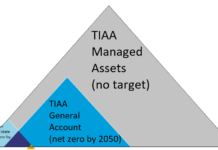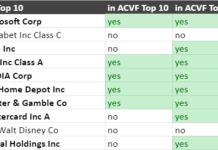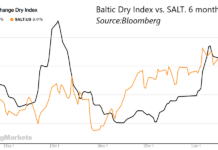This is a guest post by Brad Wright, who felt that my "Beginners" series was a too high level to really live up to the name. He’s probably right about that, so here is his effort to bring it down to basics for the small Canadian investor. The links and section headers are mine. Tom Konrad.
Motivation
The goal of this article is to assist with your future investments by explaining investment options, how they work and potential alternatives that may be of interest to you. The take away I’m looking for is with a little research you can empower yourself to make more socially and environmentally responsible investment decisions.
There are long term financial advantages to investors who identify and invest in current and future clean and green companies. Recent developments in technology and the world we live in have allowed opportunities for us to invest in companies that can make a difference – and make a profit for themselves and their shareholders. For most people, the stock market is a foreign concept, but a little research can alleviate most concerns. Here are a couple of stories that may help to see where we’re trying to go.
In a recent book I read, the author described this interesting story: He and his friend ran into a ‘biker’ at a bar. The biker asked what they did for a living. They replied that they were investors. The biker elaborated on how he once received some advice on stocks, invested and lost all his money. The author went on to say how this is such as typical notion of the stock market – people get bad advice and lose their money. The author went on to say that the biker should have purchased stock in a company that he actually knew something about such as Harley Davidson. It turns out that assuming the biker had purchased stock in Harley Davidson 5 years ago, his investment would have multiplied by 5 times.
Another example is my friend who went to speak to her registered retirement savings plan (RRSP) manager. When she went in to discuss her investments, she asked what the top 3 holdings of her portfolio were. The manager replied that he didn’t know but that he could find out. A few minutes later he returned with news – the top 3 companies were oil, diamond and uranium companies. Now, this may be commonplace considering the resource extraction based economy known as Canada. When you look at the companies that are listed on the Toronto Stock Exchange the majority are mining companies. Anyways, my friend who is environmentally conscious didn’t feel comfortable that she was investing in these companies. The next question is how she can invest in companies that are more inline with her ethics.
Investment Options
Well, first let’s just provide a quick overview of the investment options that are out there. First off, there are bonds and GIC’s that are generally fixed interest rates that may or not be locked in for long term investing. They are generally around a 4% annual interest rate and can be held either inside or outside of an RRSP.
The "Registered" part of RRSP means you have agreed with the (Canadian) government that you will leave your money in the account and not take it out until you retire. This is similar to a US 401(k) plan. The government in turn does not tax you on those investments until you make a withdrawal. Now the most common entities held within RRSP are mutual funds. A mutual fund is a conglomeration of numerous companies (let’s say about 50) that the fund invests in. These mutual funds are generally invested in larger companies and may give personal rates of return of less than 0 to more than 20% per year, depending on the volatility of your mutual fund. In general, it is assumed that mutual funds provide a 10% annual rate of return. You can talk to your investment manager and select conservative, balanced or aggressive mutual funds depending on your situation, age and comfort with investing – or more specifically, comfort with fluctuating annual rates of return. My last point with RRSP’s and mutual funds is that they come with a manager who monitors and adjusts the fund over time. They generally charge 2-3% per year for this management.
An investment vehicle which takes a further step into the stock market is called an exchange traded fund (ETF). It is identical to a mutual fund in that there are normally 50 to 100 companies you can invest in. The differences are that you purchase the ETF like you would for a stock, not just sign some papers that your investment manager gives you for a mutual fund. Also, the management fee is less, usually less than 1%. Finally, some have said that the advantages of ETF’s are that they are actively traded when the markets are open while mutual funds are adjusted when the markets are closed. The advantage is that the ETF may get better deals during the day. The disadvantage of ETF’s could be that they are more closely linked to the stock market and may depreciate more when the market is doing poorly. [Note: You can find a list of the available Clean Energy ETFs here, and a discussion of the relative merits of each ETF here.]
The final investment vehicle is buying stock from one company at a time. When you do this, the only fee is to a broker, either in person, over the phone or over the internet. In person and over the phone is generally $50 to $100 to buy or sell stocks, whereas competition on the internet lowers these broker fees to the $10-$30 range. With respect to fees, the advantage of stocks, especially if they are held for 5-10 years is that you may have to pay a total of $100 to buy and sell a stock, you don’t pay a 3% management fee over that time period. For example, with $10,000 in RRSP’s over a 5 year period with a management fee of 3% would cost you $1500!
Investment Goals
So, that is a summary of common investment vehicles. [Note: this series also discussed the choice between stocks, mutual funds, and ETFs in Part I.] Other factors that you need to consider when investing are: what are you saving for, how much can you save or allocate, and how comfortable are you with risk?
So the next couple paragraphs will deal with steps to help you move away from investing in oil, diamond and uranium companies.
It just so happens that the first step is to say, hey, what if I just invest in the best or most environmentally or socially responsible oil, diamond and uranium companies. Well, you can.
The first step towards making more ethical investment decisions is researching and finding more ‘ethical’ mutual funds. Some mutual funds use social, economic and environmental criteria to select companies for their fund. For example, ethical mutual fund companies are quite similar to Environment Canada’s EcoLogo program (which is an environmental criteria program which provides its logo on approved products, for example, green cleaning products) in which the top 20% best performing companies that meet the criteria are selected for the fund. For example, most ethical mutual funds invest in PetroCanada, Royal Bank and Research in Motion. It just so happens that these are some of the largest companies in Canada, so first, your investments are relatively safe, and second, you will likely have a good rate of return.
With exchange traded funds, the exact same principles apply. For example, the Jantzi social index (JSI)is traded on the Toronto Stock Exch
ange and invests in companies like Royal Bank, PetroCanada and Research in Motion. Also interesting, if you visit the Jantzi website, they list companies that are included in the ETF and mention companies that were kicked off the list because of bad company practices such as buying-out other companies with poor performance. The issue with Canadian ETF’s is that there are very few or are relatively new. For example, the Jantzi social index just came out this summer.
What I find problematic of both ethical mutual funds and socially responsible exchange traded funds is that they still invest in large companies. Large companies in every industry sector, even sectors that you may not want to invest in such as oil and gas exploration. These investment vehicles need to provide investors with a sense of security and competitive rates of return compared to the traditional investment types. So for most people, these options are definitely a step in the right direction.
Finding Companies You Believe In
There is one final option where you can invest directly in an organization that you believe in, such as buying stock in an individual company. This is where, with a little research you can find an organization doing interesting things that you can truly get behind. The reason more people don’t do this is because of the word diversification. Most are not willing to invest in one organization or one industry sector. If you are a small investor (< $10,000), most experts say that you are unable to diversify your portfolio enough and you are at greater risk when there are fluctuations in the stock market. This is why many like the idea of mutual funds or ETF’s – the work is done for you, and you don’t really have to worry.
But what if you did a little work, what’s the advantage, what would you need to do and what could you find out? The best place to start is the Toronto Stock Exchange. There are lots of companies in many different industry sectors. Here are a few industry sectors that might be of interest to you:
- Wind power
- Solar power
- Small hydro power
- Cogeneration (usually natural gas that supplies energy and heat)
- Energy efficiency and industry optimization
- Organic food
- Solar and wind power conversion technology
- Wind turbine manufacturing
- Hydrogen fuel cells
- Ethanol production
This is just an initial list of the types of industries where there are Canadian companies that are publicly traded on the Toronto Stock Exchange. Personally, I was originally interested in wind, solar and hydro power, but realized that I needed to diversify from the renewable energy field. For example, what if the Canadian government decided not to give tax incentives to the renewable energy industry or what if oil prices drastically reduced? What would be the repercussions to a stock portfolio based on just renewable energy companies? You could take the chance, but it would probably be best to diversify. Therefore, although the above list is mostly renewable energy fields, organic food or energy efficiency and other industry sectors could add to your portfolio. Also, there are likely many socially responsible companies in other industry sectors that I have not listed above.
Risk and Reward
Now the risk here is that the majority of companies in these industry sectors are small, new or not making any money. Most invest in companies that are large cap or blue chip companies (i.e., Microsoft, Apple, Google, etc.,) – these are generally large companies. There are really three types of companies on stock exchanges – large, mid and small cap. The word cap means market capitalization and it is calculated by multiplying the price of the stock by the number of shares that are available to be purchased. Large cap companies are generally over 1 billion dollars, medium cap range from several hundred million dollars to 1 billion dollars, and small cap are generally less than 500 million.
Most stock investors like the idea of small cap companies because of growth and that they could be the next Microsoft company. Also, once companies such as Research in Motion mature, there is less growth over time. However, most people shy away from small cap companies since there is more risk involved.
My answer to this is that depending on your age you are able to allow for more risk because if you do lose your money you can still make it back over time. For example, most retired people are very conservative with their investments since they are dependent on those savings. Also, as I’ve mentioned previously, with the world we live in and the rate of developing technologies it’s possibly a very good time to risk investing in clean and green companies.
So where do you start looking? I started with internet searches. I find companies that sound interesting or have a neat product and I check to see if they are publicly traded. You can also order investment magazine subscriptions or find investment advice websites.
These interesting companies that I look at are ones that are providing a new product or is in a new field, has a market advantage, has a vision for the future and is generally making the world greener or cleaner with their work. In additional it’s good to see the experience of their board of directors, overall financials, and the outlook for the industry, etc.
So I hope this has helped provide some insight into the crazy field of investing. There are some interesting companies out there. It is easy to find out what is going on and see for yourself what you think that your hard earned dollars should be invested in. After all, these companies use your money invested in stock to do things like build solar panel plants or buy land to build wind farms. Wouldn’t it be great if you could invest in a company that was doing good things for the planet while making you some money? Sounds crazy, but it just might work. Maybe I’m optimistic, or maybe I just want to be smart with my investments.
Brad Wright holds an Environmental Science degree from the University of Guelph and a Masters of Environmental Planning from the University of Waterloo. He is currently a municipal stormwater planner and has an interest in sustainability issues. He has been researching and investing in green companies for the past three years.









That was a great summary and nice to see the Canadian perspective. Thanks to Brad for writing that.
I enjoy reading the articles on this site, and although for sure I am a beginner in the grand scheme of things, I do understand most the technical and financial content.
My wife on the other hand has no interest in “the details” – but is very concerned about where & how she can invest ethically and responsibly. This is exactly the sort of article that I can convince her to actually read and learn from!
Thanks for the kind words Greg. Yes, I see it as a sort of continuum, where we can all move towards more ethical or green investments, as long as we stay in our comfort zone. My partner for example, isn’t interested in owning individual companies but she does plan to move a portion of her retirement savings into a Jantzi type fund.